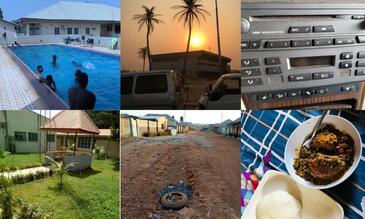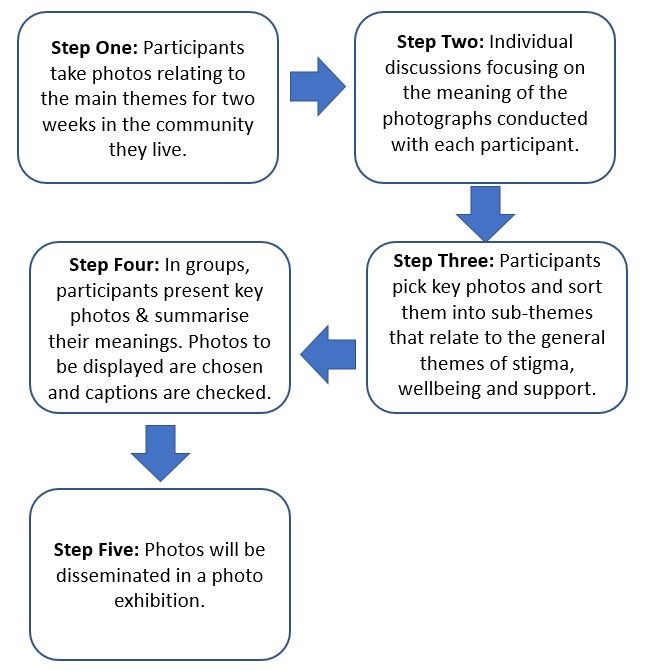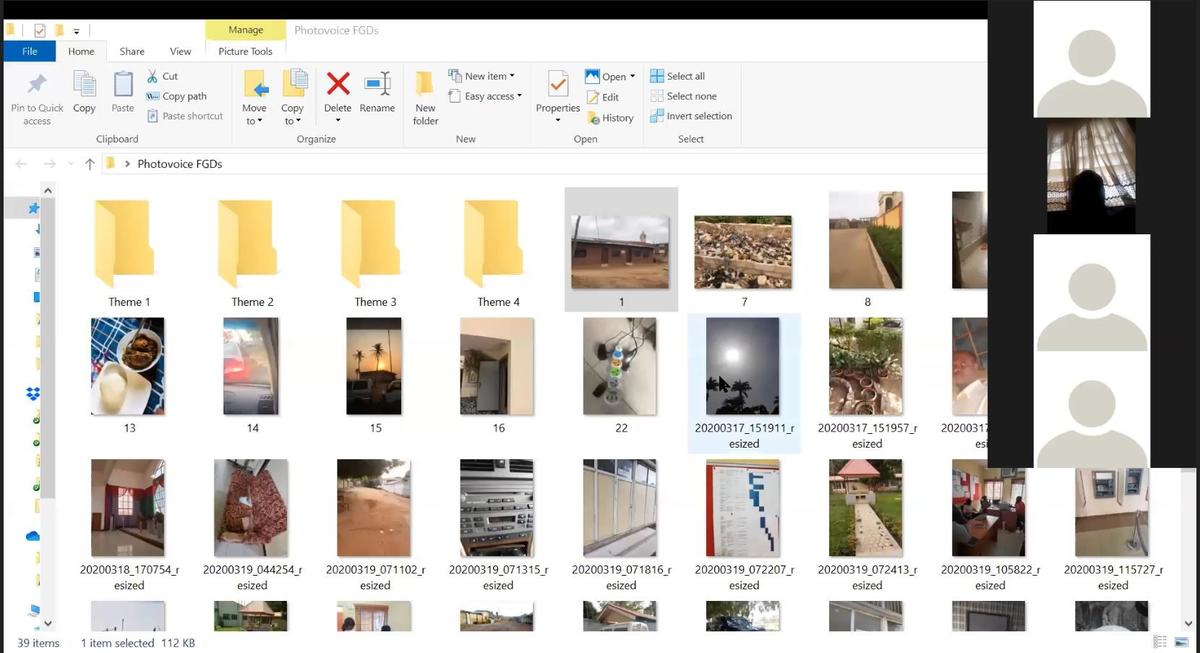
Shahreen Chowdhury, Oluwatosin Adekeye, Ayuba McRae, Adeleke Adedeji and Laura Dean
COVID-19 has presented challenges in every corner of our lives. Compared to only a month ago, the world is fundamentally a different place now. As researchers, there is a need to adapt to these changes to find ways of overcoming geographical barriers while strengthening existing partnerships. The current climate has forced us to explore alternative ways of doing participatory research. This blog will reflect on our experience of navigating this shift to remote-based training for a project based in Nigeria where we are using the method of photovoice.
What is our project all about?
The holistic health and psycho-social support of persons affected by NTDs is often overlooked in integrated NTD programme design and is an emerging area of research. Our study aims to partner with affected persons, community health workers (CHWs) and programme implementers to address this gap, through the co-design and implementation of community-based interventions such as support groups, which focus on facilitating improvements to both physical and psycho-social wellbeing. Using photovoice, we seek to understand the experiences of the health and wellbeing of people affected by stigmatising NTDs, their caregivers, and CHWs.
What is photovoice?

Photovoice is a creative participatory method, aims to empower participants to take ownership of presenting their own narratives as they choose which images to capture (Kindon et al., 2007). Traditionally, participatory methods are grounded in interactions with participants and effective partnerships often develop over time and require face to face meetings (Tami-Maury et al., 2017). The photovoice process involves participants taking photographs within their communities to capture their experiences and daily realities (Wang et al., 1996: Budig et al., 2018). The photos are followed up with a discussion to capture verbal accounts of what photographs represent and to contextualise the visual images. Images are then selected to be presented and discussed within group discussions. Some photos are further selected to share in dissemination workshops, designed to develop solutions to challenges identified and or to raise awareness of issues described in participant photo narratives. Figure one shows the process of photovoice in our study.
When researchers become the researched
During March, we had planned to conduct training for photovoice in Kwara, Nigeria and to begin to establish new partnerships with peer-researchers. However, due to travel restrictions as a result of COVID-19, this was no longer possible. We had to rethink alternative ways of conducting the training remotely. We decided to pilot the photovoice activity between the UK and Nigerian research team, to first try it as participants, before conducting the training with peer researchers either remotely or in the field.

Essentially, as the research team, we mirrored the steps we were planning to take in the field, as described in fig.1. We took photos of our surroundings that represented our perceptions of wellbeing. However, the individual and group discussions were conducted virtually, using video conference technology, such as Skype and Zoom. Screen sharing facilitated the process as both the facilitator and the participants were able to view the photos simultaneously in real-time as they were being discussed (fig.2).
[Video 1 ] “Hope” In this excerpt from the group discussion, Adekeye describes the context behind this photo: ‘This photo represents a life that comes out of dryness. There is hope no matter what is going on, there is always hope. After a long dry season, the plants are green, and this makes me feel hopeful.’
[Video 2 ] “Social disconnect” Adedeji describes why he took this photo: When I took this picture, I had the thought of disconnection. The sockets represent society while the plug is each individual. Due to different reasons and factors, the plugs can be disconnected from the sockets. The individuals may have ailments or experience stigmatisation and therefore, have that disconnection from society.’
During data collection, photos for the group discussions will be printed and sorted into themes written on flipchart paper. However, in our virtual process, the theming occurred virtually, through sorting similar photos into thematic folders on screen (video 3) – this included physical, environmental, social and emotional wellbeing. Following this, 2-3 key photos from each theme were selected as a group and their associated captions were finalised; the final photographs can be viewed here .
[Video 3] The virtual process of grouping photos into thematic folders
Our Five Key Learnings
1. Becoming participants allowed us to reflect on our positionality and discuss this as a research team
‘The process was also learning for me because taking the pictures meant taking a closer look at how participants may be able to understand and carry out the task themselves. Understanding the different areas and aspects of wellbeing and being able to relate it by taking pictures…It helped me reflect on my role as a participant and a researcher putting myself in the shoes of would-be participants.’ (Adekeye, Team Lead)
As this was our first time using photovoice as a method, this pilot allowed us to reflect on our roles as both a participant and researcher. This enabled a better understanding of the photovoice process, and how to relate with participants during training and implementation. Throughout the virtual pilot, we often shifted roles from participant to researcher as we took turns to ask questions of each other. This provided further insight to the process and to allow the conversation to evolve and continue without it becoming mechanical.
2. The virtual process highlighted the pitfalls and possibilities of technology and connection
Connectivity, in both human and technical senses, is key to effective virtual training. In a technical sense, connection issues presented challenges. While video conference technology has revolutionised remote based working, it ultimately relies on good internet connection. This is not always possible, especially when working across international borders. Strong internet connection is a privilege, but this needs to be made accessible if we are to move to virtual methods of working, particularly in the Global South. There was one instance where we had to reschedule a call but this was overcome through clear communication across the team. Being adaptable and flexible is important in mitigating challenges in virtual communications.
Navigating the shift from traditionally face to face training to virtual could also present another challenge related to human connection, particularly in social research. The absence of face to face communication could possibly hinder the development of trust in the research process (Tami-Maury et al., 2017). In qualitative research, building a rapport is key to effective participant engagement. As a team, we have all met before therefore this did not present a challenge in this particular activity. However, recognising that faceless communication can sometimes depersonalise situations, we decided to use video calls to introduce ourselves. On the other hand, faceless communication may also be an advantage, especially if participants wish to remain anonymous when discussing sensitive issues. The benefits and challenges of face to face technology is, therefore, context-specific to particular projects and participants.
3. Photovoice requires commitment and time
‘Though I initially felt the first meeting was lengthy but later I appreciated the time since it helped in giving us the true meaning of the pictures which made me realize how we can sit with participants… and also to make the activity interactive so as that they, in turn, can and will choose the best photos’. (Mcrae, Field Coordinator)
Photovoice is a method that takes time in order to obtain rich, meaningful data. By going through the process, we realised while it can be time-consuming, this method requires commitment from everyone involved. Photovoice encourages individuals to be the storytellers of their own narratives and lived realities. It is therefore important to ensure that participants do not feel rushed and are comfortable discussing their photos freely, particularly on issues related to mental health and wellbeing.
4. “Photos speak” (Adekeye, Team Lead) Photovoice captures the power of imagery and incites critical reflections and discussions
‘It shows how strong a picture can send a message. Without even saying much, the picture itself can almost speak for you. I was able to understand how one picture can have multiple meanings citing an example with our pictures of ATMs. I and Dr Tosin both had pictures of ATM machines [fig 3 and fig 4] but each of us had different views of wellbeing.’ (Mcrae, Field Coordinator)

Figure 3. ‘Due to the current situation, I needed to stock the house so I had to go the ATM and what was on my mind was that I had to take money out of my savings because I didn’t plan for this to happen. I took the photo of two ATM machines to show that indecision’ (Adekeye, Team Lead)

Figure 4. ‘I went to the ATM machine and in no time, 5 minutes, I was able to withdraw some cash and it makes me think how the ATM makes life easier. Imagine if I had to go into the bank and spend one or two hours just for 2000 naira but at the ATM it only takes 5 minutes and I can get on with my day’ (McRae, Field Coordinator)
‘The activity served as an opportunity for both reflection and learning with respect to my wellbeing…also allowed me to explore the relationship between my environment reflected by taking photos and how I felt inside which is something usually not openly seen.’ (Adekeye, Team Lead)
Photovoice as a transformative tool to stimulate critical reflection around abstract thoughts is highlighted. Wellbeing is often “something not openly seen”. However, photos representing various aspects of emotional, physical and environmental wellbeing sparked conversations amongst participants and allowed discussions and deconstructions around perceptions of wellbeing. Images can be powerful, and they can be recognised beyond literacy levels, culture, and language.
5. Creating a virtual safe space is a key factor in the process.
‘The duty of the facilitator is to explain what is to be done and not dictate to participants what to say’ (Adedeji, Field Coordinator)
Photovoice aims to shift the power balance away from academics holding the authority on knowledge, toward individuals who are active participants in the research. Participants direct the way their photos and stories are represented and shape what becomes knowledge and truth in relation to their own experience. The facilitator’s role is to enable participants the space to do this.
Coupled with the fact that there is no wrong or right answer, participants coming together and developing captions for selected photos also helped individuals express themselves within the context of the photographs; this allowed room for a positive and productive interaction between the facilitator and the participants.
Video conferencing, however, also raises new considerations regarding the security and storage of data. Therefore, discussions should be conducted over secure conference platforms. Similarly, as in the field, data collection and any recordings should be stored in password-protected databases, in line with ethics and data protection guidelines.
Final Thoughts
While COVID-19 has altered how we had planned to conduct our training, it has also presented new opportunities and ways of doing research. We have had to re-think our traditional approaches of conducting training and it has allowed us to reflect and adapt in ways we have not before. Virtual platforms offer unique ways of working in partnership beyond borders. Our experiences reflect that this process requires commitment, some creativity, and reflexivity, as well as clear communication.
Through virtually conducting the photovoice activity as a team, we were able to reflect on our own positionalities and refine the process to make sense for participants and co-researchers. Virtual platforms allowed us to be more reflexive in our roles as researchers. Photovoice, like all participatory methods, is iterative, where we make mistakes and learn as we go on. We look forward to taking these learnings forward as the training commences in the field.
